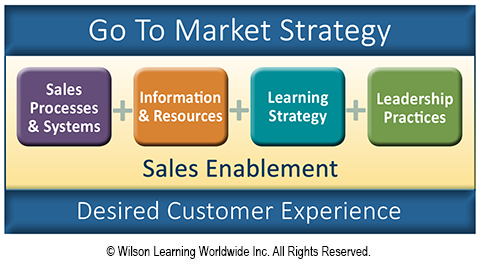Le secret de l’aide à la vente
comment combler l’écart entre la stratégie des ventes et

A compelling conversation under the title “Sales Enablement” is unfolding among thought leaders in sales and marketing. The initial emphasis on sales enablement grew out of what Harvard Business Review calls “the notoriously fraught relationship between sales and marketing.” As companies sought solutions to better align sales and marketing to drive better revenue results, people started to talk about how other functions could and should also be better approached and aligned in order to enable sales. Yet, as with any exciting evolution, there is a lot of buzz but not necessarily a great deal of clarity as to what it means. So what exactly is sales enablement, why does it matter to your business, and what are the keys to doing it well?
Before we define sales enablement, let’s first look at why it matters.
Why Does Sales Enablement Matter?
Everyone wants “a piece” of the sales-force. Internal functions—such as marketing, training, research and development, and sales operations—all have information they want to get out to sales. Well-intentioned efforts to help equip your salespeople with knowledge, information, and resources may actually be wasting precious selling time as your sales-force struggles to make sense of it all. Let’s look at some of the symptoms that might indicate opportunities for improving your company’s efforts at sales enablement.
- Have your internal processes failed to keep pace with the way your customers prefer to shop, buy, and use your company’s products or services?
- Are you hearing customers and salespeople complain about information overload?
- Are various internal functions competing for your salespeople’s time?
- Are your salespeople receiving conflicting messages from different sources?
- Is time being wasted in training that is not relevant to the learner?
A Better Way—Sales Enablement
Put simply, sales enablement is an approach that bridges the gap between the sales strategy and execution. It helps organisations provide their sales-force with all the information and resources they need to generate revenue. And it ensures that every action you take aligns with the overall strategy of your organisation and with the way you want your customers to experience your brand.
For example, one organisation who adopted a sales enablement strategy was able to increase sales productivity by 15%. They achieved this by reducing time out of the field, increasing available selling time, reducing travel costs, and providing enhanced technology that made it easier for sales representatives to find and share resources based on individual buyer needs.
What Sales Enablement Isn’t
Sales enablement is a new term and many companies make the mistake of applying the new term to old ways of doing things. They rename “sales training” to “sales enablement” or they decide to create more mobile or other technology-assisted selling tools and call these sales enablement. The reality is that learning and technology are important to sales enablement, but they are only parts of the equation, and focusing on any one element in a vacuum is likely to produce limited results.
What’s Critical for Success?

A systems view of sales enablement includes four core elements that must be aligned with one another, your organisation’s go-to-market strategy, and your vision for the desired customer experience. Achieving or improving this triple alignment of the four core elements, strategy, and customer experience is the ultimate objective of sales enablement.
Let’s consider each of the four elements that make up our sales enablement model.
Process Mesh or Mess?
All too often the sales processes and systems that are intended to help drive results actually end up conflicting with one another and consuming time. Consider the following questions:
- Does your sales-force rely on, or avoid, your CRM system?
- Do you have a consistent, defined sales process? Do your people use it?
- Even if your sales processes and systems satisfy the internal requirements of your sales organisation, how well do they mesh with your customers’ shopping and purchasing processes?
- Do you fully understand the dependencies in the way these processes interact?
A sales enablement audit can identify inefficiencies and point the way to improvements that shorten the time it takes for prospects to become customers.
Information: Access or Overload?
A sales enablement approach to information and resources focuses on the optimal streams of information aimed at the sales-force, support staff, current customers, and prospects. When these flows are orchestrated by a sales enablement strategy, the sales process begins to synchronise more closely with the “shop and buy” cycles of your customer organisations. Instead of being overwhelmed by the constant push of information into their space from other parts of the organisation, salespeople begin to pull critical information toward themselves and skillfully guide it toward customers. Instead of simply reacting to customer enquiries, salespeople and support staff are able to anticipate customer questions and, as a result, the information provided by your sales team begins to be seen as an important source of value to customers.
Learning Clutter or Learning Strategy
Rather than just reorganising or renaming sales training, genuine sales enablement requires L&D professionals to up their game, rethink their work, and re-frame their role. In order to support sales enablement, L&D needs to:
- Develop a learning strategy that is aligned both with your organisation’s go-to-market strategy and with your vision for the desired customer experience
- Partner with sales leadership to identify and define the behaviours and mindsets necessary to execute on the organisation’s specific objectives and go-to-market strategy
- Equip sales with the knowledge and skills to engage prospects and customers and drive sales forward
- Ensure sales leaders are equipped to coach salespeople toward higher levels of performance
- Increase their consulting presence to help identify barriers to successful sales performance and drive solutions that go beyond training and development
Leadership: Tactical and Practical
No element has a greater impact on sales effectiveness than the day-to-day practises of sales leadership. Unfortunately, few organisations take the time to actively ensure that all the learning, information, and systems described above become integrated into leaders’ actions. A sales enablement approach entails asking the following questions and addressing identified disconnects and gaps:
- Do the everyday actions of sales managers and their bosses align with both the organisation’s strategy and the desired customer experience?
- Do leaders coach to the sales process? To the information strategy? To the learning strategy?
- Do leaders know what to coach on, how to coach, and why it’s important?
- Are leaders holding each other accountable for alignment and performance?
- Who, in a very practical sense, is coaching the coaches?
Cross-Functional Collaboration
Sales enablement requires new levels of cross-functional collaboration. More than ever, the productivity of the sales-force is tied to how effectively marketing and other internal support teams work with sales and each other.
According to a Forrester report, “. . . you need to develop a team to work across traditional organisational boundaries and reporting levels within your company—and that’s a big challenge. But eventually, to be successful with sales enablement, you need to break down the walls between organisational silos to get customers the information they need.”
A well-planned and executed systems approach to sales enablement can yield increases in sales, as well as cost savings, by allowing an organisation to be more strategic in managing how information is shared and accessed. Done well, it will reduce redundancies, eliminate time spent searching for information and resources, and limit time spent out of the field. Done poorly, sales enablement is just another fad that will disappoint and then disappear.
Pour en savoir plus, contactez Wilson Learning au 01 47 51 70 70 or rendez-vous sur notre site Internet at WilsonLearning.com.








 Merci de remplir ce formulaire afin de télécharger Le secret de l’aide à la vente | comment combler l’écart entre la stratégie des ventes et».
Merci de remplir ce formulaire afin de télécharger Le secret de l’aide à la vente | comment combler l’écart entre la stratégie des ventes et».



